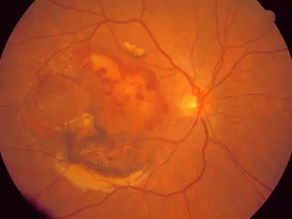Age-related Macular Degeneration
Age-related macular degeneration (AMD) is a degenerative disease that impacts the macula, the central part of the retina responsible for sharp, central vision. As this condition progresses, it can significantly affect one's ability to see clearly and engage in daily activities. Join us as we explore the causes, symptoms, and available treatments for AMD, empowering you with knowledge to better understand and manage this age-related eye condition.

Risk factors for AMD include old age, smoking, high blood pressure and a diet high in saturated fat.
Age-related macular degeneration (AMD) causes blurring of your central vision that is caused by damage to the macula because of aging. Macula is the central part of the retina that is important for central vision.
AMD is the most common cause of severe loss of eyesight among people 50 and older. It does not cause complete blindness, but losing the central vision can make it difficult to see faces, reading or driving.
AMD is a slowly progressive disease in most cases, while in a few, it can progress fast and cause severe vision loss. Depending on the type of AMD, you may have early changes, but it may not affect your vision for a long time. To know whether you have AMD, or the type of AMD, it is important to get an eye examination from an eye professional. Once you are diagnosed with AMD, it is important you get a regular checkup to make sure the disease is not progressive.
There are two types of AMD – the dry type, which is more common, and the wet type, which can lead to a significant loss in vision.
The dry AMD is a slowly progressive type of AMD, which is usually divided into three stages – early, intermediate, and late. Early to sometimes even in intermediate stage, vision does not get affected, and hence an eye examination is a must. There is no treatment for early AMD, while for intermediate type of AMD, where your central vision may get mildly blurred, the doctor can advise you to take special vitamins and minerals that have demonstrated to slow the progression in the disease in clinical trials. Treatment may be advised for late stage of dry AMD, also called Geographic Atrophy (GA), where patients increase in blurriness of vision, along with straight lines that look crooked. This disease impacts more than one million Americans and about five million people worldwide. In later stages, the central vision may get enlarged and/or you may be unable to see in the central part of the vision. Two recent intraocular injections have been approved, Syfovre (Apellis Pharmaceuticals, Inc.) and Izervay (Iveric Bio, an Astellas Company), for patients with GA. These medications are only approved in the United States at this time, while they are under review in Europe. Note: Please discuss with your doctor about the benefits versus the risks of these injections before you sign the consent form.
Wet AMD is not as common as the dry type, but it may cause significant visual loss. Any stage of dry AMD can turn into wet type and hence it is important to maintain regular follow-ups with your eye doctor. In wet AMD, new blood vessels grow behind the retina and cause bleeding, swelling, and exudation in the back of the eye, which can lead to the loss of vision.
The usual treatment for wet AMD is an intraocular injection, which is given monthly and bimonthly to begin with, and may be given at extended periods of time, depending on the course of the disease as per the doctor’s assessment. These injections tend to reduce the swelling in the back of the eye, which helps improve vision. Injections may be required for a longer period of time, or maybe switched from one type of injection to another, if the disease does not tend to come in control.
Some of the intraocular injections that are prescribed and given for wet AMD are Lucentis (Genentech/Roche), Eylea (Regeneron/Bayer), Beovu (Novartis) and Vabysmo (Genentech/Roche). Avastin (Genentech/Roche) is also prescribed by many eye doctors.







